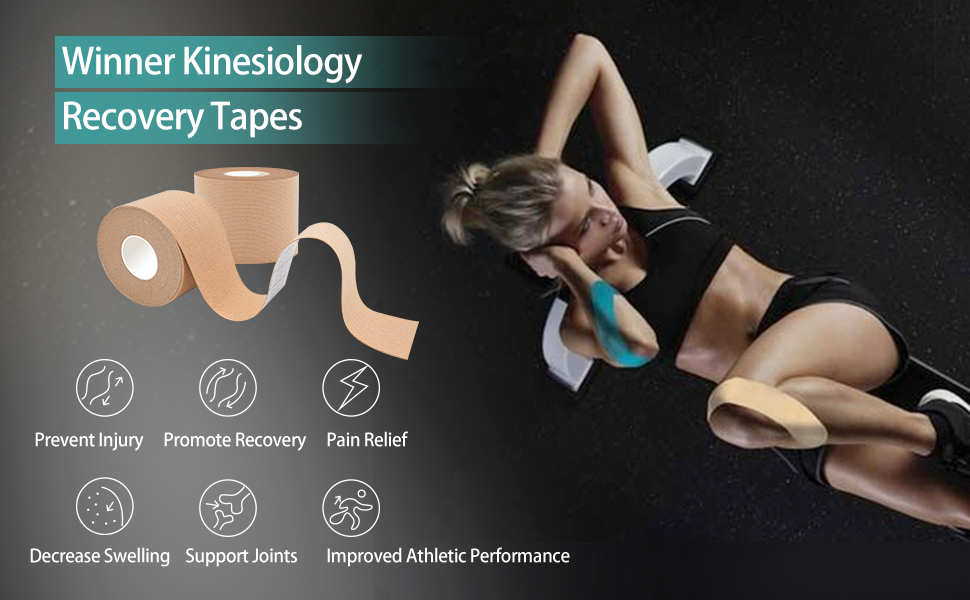03/09/2024
ByWinner Medical
 629
629

The Paris 2024 Olympic Games have sparked the public's passion for sports across the globe. Various sporting events, such as swimming, badminton, volleyball, basketball, and tennis, attract people to be actively involved in sports activities.
Although sports can be helpful in enhancing physical strength and improving the quality of life, sports injuries are a common problem that cannot be ignored. Sprains, strains, abrasions, and even fractures not only cause pain but may also hinder our motivation to exercise.
How to prevent sports injuries? Some measures are important to enjoy sports better and avoid unnecessary pain and recovery time. In this article, we will introduce effective measures of care and prevention of athletic injuries, helping you to minimize the risks and enjoy exercise with peace of mind!

How to Effectively Prevent Sports Injuries?
Common sports injuries are often caused by insufficient preparation before exercise or by ignoring abnormal signals from the body after exercise. How to prevent sports injuries? To keep you active on the sports field, here are some injury prevention exercises:
1. Stretching Before and After Exercise
Stretching before and after exercise is one of the most important injury-prevention exercises for sports injury prevention.
Before exercise, stretching helps increase the range of motion, flexibility, and blood circulation to the muscles, reducing the risk of injury. For example, leg stretches, arm swings, and light jumping can help the body gradually get into exercise states.
After exercise, stretching helps to relax the muscles, reducing post-exercise muscle tension and avoiding cramping. Static stretching exercises are recommended, such as stretching the hamstrings, muscles, and back in a sitting or standing position, to improve muscle flexibility.
2. Learn the Correct Exercise Posture
Learning correct exercise techniques and postures can reduce unnecessary muscle stress and loading to avoid sports injuries, especially in high-intensity sports such as swimming, track and field, and soccer.
If you are not sure whether the posture is correct, you can learn the sports posture and techniques of professional athletes at the Paris 2024 Olympic Games. Secondly, make sure your body is balanced during exercise. For example, keep your body upright when running and do not lean forward or backward excessively.
Finally, it is also crucial to gradually improve your posture and not rush to increase the exercise intensity.
3. Gradually Increase the Exercise Intensity
Most sports injuries are often caused by overtraining. Suddenly increasing the time or intensity of exercise may result in an increased load on the body and cause a sports injury.
How to safely increase the exercise intensity? First, divide your exercise program into phases, each with a defined intensity and duration. A 10 % increase in the amount of your weekly activity may be most appropriate. [1]
Second, changing the type of exercise appropriately, such as a combination of aerobic exercise and strength training, can help avoid repetitive use injuries. During exercise, if you feel shortness of breath, pain, or persistent fatigue, you need to reduce the intensity and rest appropriately.
4. Choose Protective Gear
Wearing suitable sports clothing and protective equipment in sports can provide the necessary support and protection. You can choose according to the type of sport, which usually includes sports shoes, sportswear, helmets, knee braces, wrist braces, shoulder braces, and other protective gear.
Pay attention to the fact that shoes should fit your feet closely and have good cushioning. Sportswear should be made of breathable and soft materials such as polyester or nylon. The fabric of the protective gear should be soft and supportive for comfort and stability.
5. Use Sports Bandages for Injury Prevention and Post-injury Care
How to prevent sports injuries? In addition to the measures mentioned above, the use of sports bandages can also help care and prevention of athletic injuries. Sports bandages can immobilize muscles or bones in specific positions and provide additional support. This helps prevent sprains, fractures, or other possible injuries.
Moreover, sports bandages can help reduce swelling, relieve pain, and prevent further injury. Restricting the range of motion of muscles and joints through first-aid bandages can help the body heal faster than it would without restricting movement.
Different first-aid bandages have different functions and features. Here is a detailed analysis:
A. Elastic Bandages
lSoft and highly elastic, elastic bandages are commonly used to bandage joints and muscles, providing essential support and stability to injury-prone areas.
lBy applying moderate compression, the bandage increases blood circulation to reduce swelling.
lIt can also limit the range of motion to prevent further injury.
B. Athletic Tape
lWith good elasticity and breathability, athletic tape can be adapted to different body parts.
lUsed to immobilize joints and muscles, providing extra support and stability.
lPrevent excessive movement of joints such as ankles, knees, and wrists.
C. Cohesive Bandages
lThere is no need for clips or pins. Cohesive bandages are coated with a special adhesive that can adhere to the skin, providing a stable wrap.
lUsually used for minor support and immobilization, it is not easy to come off.
lWith good breathability, it can reduce friction and irritation to the skin.
lSuitable for wounds of all sizes and shapes, including fingers, wrists, ankles, and other areas.
D. Supportive Bandages
lDesigned to be used on specific areas such as knees, ankles, and wrists to provide extra support and protection.
lOptional braces with extra padding or metal supports are available for stability.
E. Compression Bandages
lIt helps control swelling and hematoma formation by maintaining proper pressure on the wound.
lUsually used immediately after an acute injury such as a sprain or strain.
lUsed to prevent muscle strains and other soft tissue injuries.
F. Gauze Bandages
lUsually made of cotton, gauze bandages are commonly used to dress open wounds, providing protection and absorbing exudate.
lIt can be combined with elastic bandages or athletic tapes for added immobilization.

Simple Nursing Methods After Sports Injuries
Now, you know the answer to “How to prevent sports injuries?” While the precautions mentioned above greatly reduce the risk of sports injuries, sports injuries can not be avoided completely. Proper care can help speed recovery and minimize complications. The following first aid for sports injuries can be taken:
Minor pain and wounds can be treated with the RICE (rest, ice, compression, and elevation) principle. [2]
lImmediately stop activity and allow the injured area to rest.
lUse an ice pack in a towel on the injured area as soon as possible.
lWrap the injured or painful area with an elastic bandage.
lElevate the injured or painful area to minimize swelling.
For serious sports injuries, stop all activity, do not move the injured area, and seek immediate medical attention. The doctor will determine if surgery or fixation of the injured area with splints and bandages is necessary.
For severe wounds, the doctor may also use compression bandages to help control swelling. During recovery, patients can use gauze bandages to protect the injured area while absorbing wound exudate and promoting healing.
In severe cases, the most important thing is to follow professional medical advice and organize a proper treatment and rehabilitation plan to speed up the recovery process.
Winner Medical’s Sports Bandages for Injury Prevention and Post-injury Care
Whether swimming or playing tennis with friends, taking adequate sports injury prevention exercises is the key to enjoying sports.
Winner Medical offers various types of bandages, including elastic bandages, athletic tapes, cohesive bandages, supportive bandages, compression bandages, and gauze bandages, which can provide reliable fixation for muscles and joints, protect wounds, and improve blood circulation, thereby reducing swelling and inflammation.
Our bandages are made of soft and breathable cotton or non-woven fabric material, which can provide maximum comfort for both injury prevention during exercise and recovery and treatment after injury.

Conclusion
How to prevent sports injuries? In conclusion, although sports injuries are common in sports activities, we can prevent injuries through stretching, proper exercise technique, protective equipment in sports, and the use of sports bandages. When dealing with sports injuries, the first aid for sports injuries mentioned above can be taken.
At Winner Medical, we offer a wide range of bandages and dressings to help prevent or care for your injuries. Contact us for more specific information!
References
[1] Exercise intensity: How to measure it. Available at: https://www.mayoclinic.org/healthy-lifestyle/fitness/in-depth/exercise-intensity/art-20046887 (Accessed: 14 August 2024)
[2] RICE (rest, ice, compression, and elevation). Available at: https://ukhealthcare.uky.edu/orthopaedic-surgery-sports-medicine/treatment/rice (Accessed: 14 August 2024)